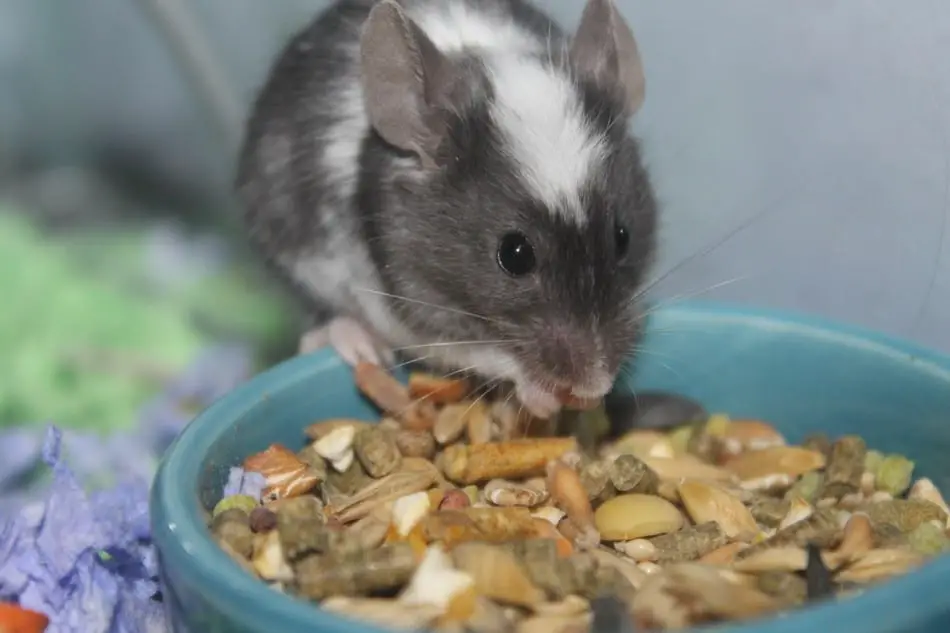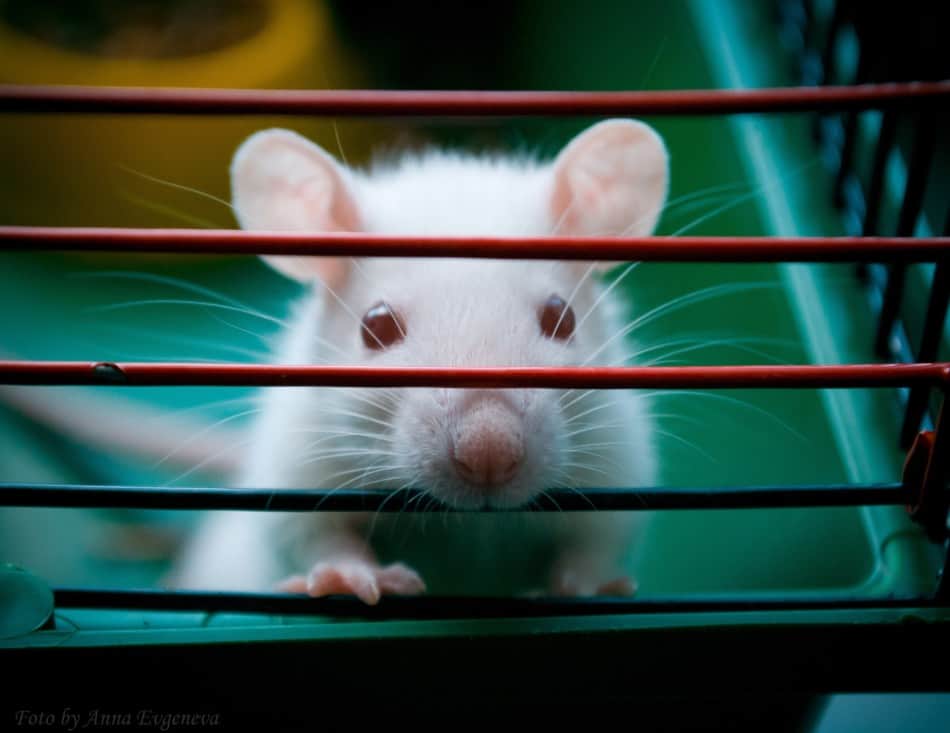One of the most important aspects of a mouse cage is the spacing between the bars. To keep your mouse secure, the bar spacing should be no more than ¼ inch. This is just enough to allow them to see and breathe freely. When the bars are placed too far apart, mice find themselves able to escape. This is because they are so nimble and small.
Bar spacing for mice: Allow no more than 1/4 inch or 6mm spacing between the bars of your mouse cage. This will allow you pet mice to feel free and not caged in but also not allow them to escape.
Table of Contents
What Size Should My Mouse Cage Be?
Your mouse cage should be no less than 2 square feet in size, for 2-4 mice. Your mouse is sure to appreciate more. These energetic creatures appreciate having ample room to roam.
Highly recommended is to go for a two-tier cage, to maximize all of the space available. A cage with two levels can literally double the amount of space your mouse will have.
Another way to amplify the cage space is to include ramps. These can go from side to side, up the cage, creating additional levels for your mouse to scurry on.
3 Pet Mice cages we recommend!
Prevue Pet Products 528 Universal Small Animal Home, Dark Gray
3 used from $92.57
Features
- Designed to home a wide variety of small animals
- Tight 3/8'' wire spacing
- Extra deep 6 1/4'' tubby base
- 2 large entry doors – one on top and one on the side
- 32 ½’’ L x 19’’ W x 17 ½’’ H with 3/8’’ wire spacing
Savic Mickey 2 XL Spacious Mouse & Dwarf Hamster Cage
Features
- EVERYTHING YOU NEED: The cage comes with lots of accessories including Sputnik rat house, water bottle, exercise wheel, feeding bowl, wire platform and metro tunnels.
- HUGE SIZE: The Mickey Extra-large cage lets you build a heavenly home for you hamster. The cage measures 31. 5in x 20in x 20in with narrow bar spacing
- LARGE BASE: The large lower area ensures your pet will have lots of frolicking and tunneling fun.
- EASY TO MOVE: The cage comes with two large handles so you can move the cage to any location. The large door gives you easy access to your hamster.
- The cage is proudly made in Belgium. Additional tubes are available to customize you hamster house.
4 Level Sparkle Hamster Mice Mouse Cage with Large Top Exercise Ball 25" Height
Features
- 【16"Length x 11"Depth x 25"Height 】3-Full Levels With 3 Front Metal Wire Access Doors, Plus Top Lookout Level With Large 6" Diameter Running Ball. Acrylic Clear Cross Level Tube Tunnel Included【Complete Features Includes, Total 3 Exercise wheels, Total 3 Food Dishes, and 1 Water Bottle】
- 【Includes Complete Set of Accessories】Total 3 x Exercise Running Wheels, Total 3 x Food Dishes, 3 x Expansion Outlets, and 1 x Water Bottle
- 【Expandable and Customizable】Able to Expand and Completely Compatible "Mcage" Accessories For More Space.. New design fully solid plastic shelf and easy to assembly without clips. Completely transparent to facilitate observation.
- 【3/8 inch wire body】 Bar Thikcness: 1/16". White Wire Body Prevent Escape and Stuck
- Easy To Setup Without Tools. For dwarf Hamsters, Hamsters, Gerbils, Mouse, Mice or other small animals critters
What is the Best Mouse Cage Material?
You have probably seen cages made of a few different materials at the pet store. The most common are plastic and metal. Generally speaking, you will want to go for one of the cages made of metal.
Plastic cages tend to be something that your mouse can (and will) chew. However, some plastic is extra-durable and can work. Use your best judgment, here.
The components of your mouse cage do not need to be made of metal. For instance, ramps can be made of chewable wood (such as aspen). You can also include items especially for your mouse chew on. There are sticks, blocks, and the like.

Where To Keep Your Mouse Cage
Where you keep your mouse cage is also of importance. You should find an area where your mouse can socialize, but it is not too noisy. A sitting room or bedroom is ideal.
Mice have very sensitive ears and should generally not be in a room with a TV (at least, if it is playing loudly).
Should you be able, it will make your mice feel safer if you place their cage up high. This will also help protect them from pets, young children, and so on. Along with this, be sure to prevent aggressive pets and young children from entering the room.
This will understandably cause your mouse quite the scare!
Give Your Mouse a Tiny Mouse House
Naturally, mice are accustomed to the small, enclosed space of a burrow. Including an enclosure or two is a surefire way to help them feel more secure, comfortable, and at home.
A mouse house can be made out of a large margarine container or a small box. You can also purchase a quality, long-lasting ceramic mouse house online.

Bedding For Your Mouse
One of the very most important facets of a mouse cage is the bedding that you use. Some things you should never use are cat litter or stringy fibers that could potentially cause your mouse to choke.
Your best options are paper-based beddings, such as plain old fashioned paper shreds, or paper mulch. Aspen wood shavings are another great choice.
The benefits of paper bedding are many. This is a material that is readily available, and affordable. Paper is also super absorbent, soft, springy, and all-round comfortable and effective. Just be sure not to use a newspaper or any other kind of paper with ink.
Wood shavings have much to offer as well. Aspen wood shavings are particularly ideal. This is a type of wood that is naturally toxin and allergen-free. Aspen wood shavings are also nice and affordable and can be found at your local pet store.
Never use shavings made from cedar or pine. These are two kinds of wood that are known to emit toxic fumes upon coming in contact with urine. Aspen wood shavings can safely absorb urine, water spills, food spills, and the like.
Read: What do mice need in a cage article for a full list of the products you’ll need for your pet mouse.
Exercise Wheel
Every rodent needs their very own exercise wheel. Mice, in particular, are very active! An exercise wheel will allow them to get their energy out, and prove very good for their health.
When you are sleeping, an exercise wheel is a fantastic way to keep your mouse occupied. They get a lot of use out of their exercise wheels at night, because they are nocturnal.
There are a few things you will want to consider when picking out an exercise wheel. The first is the material that it is made of. The exercise wheel should be crafted from a sturdy metal. This will prevent your mouse from chewing the wheel up over time.
There should be a flat surface on the exercise wheel; rungs can cause your mouse harm. They tend to get their fragile paws stuck.
Feeding Your Mouse
Now that your mouse is all settled in, they are sure to be hungry. There are several foods that you can safely feed your mouse. Primarily, mice should consume mouse food from the pet store.
Muesli-based food tends to be a favorite. This should provide a solid dietary foundation. Your mouse can also enjoy treats every once in a while.
In fact, you can feed certain fruit and veggies to your mouse. Bananas, pears, plums, carrots, cabbage, and apples all make a fine treat or snack.
Watering Your Mouse
Your mouse will need constant access to freshwater as well. The best way to provide this to them is with a water bottle and steel ball. Mice will tend to knock over and dirty a bowl.
Read our guide on: Watering your pet mouse here!
Toys for Your Mouse
Mice love to play! Spruce up their can with a few toys and you are sure to make them happy. Mice love to chew on toys made from rawhide. Empty toilet paper rolls can be made into little tunnels for them to run and hide in. Your mouse will also make good use of wooden toys to chew.
Keeping Your Mouse Cage Clean
Did you know that mice actually prefer to be clean and tidy? Their reputation for filth was more situational. In a nice, hygienic environment, mice are quite fastidious. They will groom themselves, and each other. Sometimes, they can be taught to use a litter box.
Still, your mouse cannot change out their bedding on their own! This must be done at least a few times a week.
Switch out the water bottle frequently as well. This will prevent it from becoming stale. You also want to check that the steel ball does not become stuck.
Best alternative bedding review!

Let Your Mouse Out of Their Cage to Explore
You can let your mouse out of their cage under very special circumstances. Remember, mice are quite small and find it pretty easy to run and hide. When removing your mouse from their cage, you will want to be in an area that has been made mouse-proof.
This means covering all of the holes, exits, poisonous houseplants, dangerous cords, and so on. Once all of this has been done, your mouse may come out to explore.
If your mouse is safe, warm and cosy they will live a happy life. If they become stressed or unhappy they could go into a state of Torpor. Read all about Torpor in mice here in one of our articles on the topic.
Final Thoughts: Bar spacing for mice cages
As you can see, like all animals, mice have some pretty specific requirements for their cage. Luckily they are quite simple. The bars must be no more than ¼ inch apart, to prevent escape. For 2-4 mice, a cage should be at least 2 square feet in size.
You can get a two-level cage so that they have double the area. And include ramps, so create yet another level. You can keep your mouse busy with an exercise wheel.
Your mouse will also treasure their very own mouse house in which to sleep and hide. Create the perfect habitat to keep your mouse healthy and happy, and to help them feel at home.











